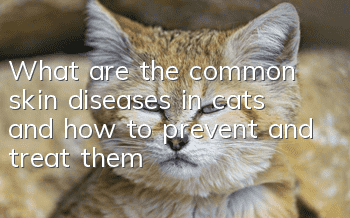What are the common skin diseases in cats and how to prevent and treat them?

1. What are the common skin diseases in cats?
1. Flea allergy dermatitis: As the name suggests, small red papules appear on the wound after a flea bite. The wound appears after the cat scratches it due to itching. Sometimes the wound is combined with fungal and bacterial infections. , causing the lesion area to expand and become larger.
2. Scabies: This is a scabies parasite that first infests the ears, then attacks the head, and then the whole body. When this scabies eats animal dander tissue, it will cause severe It is itchy, so when you find that the kitten keeps scratching its ears and shaking its head, you should pay attention. It may even have scabs, ulcers, pustules... Please stop "observing" and send it to the hospital for treatment!
3. Ringworm: Cats under one year old are easily infected with ringworm, which is a special kind of mold. The typical symptoms are irregular round hair loss areas, mixed with scaly spots and scars, and sometimes There are also allergic papules. This kind of ringworm is highly contagious and common to humans and animals. Once discovered, it must be treated and controlled as soon as possible.
2. Treatment methods and preventive measures for skin diseases
1. Treatment methods for cat skin diseases
Different types of skin diseases have different treatment methods. For skin diseases caused by bacteria, fungi or parasites, the treatment methods are nothing more than medicated baths, sprays, disinfection, wearing collars, sunbathing, etc.; but for nutritional skin, For the disease, the treatment is to strengthen nutrition, such as supplementing B vitamins.
No matter which skin disease, the symptoms are similar, and when a cat’s skin defense system goes wrong, it is easy for mixed infections to occur. The symptoms we can see may not be caused by one skin disease, but 2 to 3 infections at the same time. Fungi are not out of the question. Therefore, when a cat develops a skin disease, we must take the cat to a regular pet hospital as soon as possible to identify which skin disease the cat is suffering from so that we can quickly treat it.
If you want to correctly treat cat skin diseases, you should first identify whether the cat's skin disease is mite type or fungal type. Therefore, parents need to take the cat to a regular pet hospital for testing. After confirming the type of skin and liver disease, they can then treat it and prescribe the right medicine. The general treatment method is to first cut off the hair in the affected area, then inject and apply topical medication. Some require periodic medicinal baths. In severe cases, infusion is required to achieve systemic anti-inflammatory purposes. At the same time, Ketocon tablets, griseofulvin tablets, etc. can be taken orally. In addition, during the medication period, it is best to supplement vitamins and feed more fatty foods, and do not feed cats milk and other alkaline foods.
2.Ways to prevent cat skin diseases
1) Before the rainy season comes, give the cat a bath and blow dry it.
2) All cats live in rooms facing south. They are allowed to exercise in the yard at a fixed time every day and bask in the sun. The ultraviolet rays in the sun can sterilize them.
3) The cat’s bed and litter box that cats use daily should often be exposed to the sun when they have time.
4) On rainy days and there is no sunshine, you can buy a reptile pet lamp with UV light and hang it in the cat room to shine. Look for a specially treated lamp that will not harm the animal’s eyes.
5) Feed nutritional paste frequently to increase the vitamins in their bodies and improve their immunity.
6) After the kitten is born, wash off the mucus with warm water, blow it with a hair dryer until it is eighty dry, and return it to the mother cat. This method can greatly reduce the chance of the kitten getting milk moss.
3. Can cat skin diseases be transmitted to humans?
Dermatophytosis is a problem that every dog parent and cat mother will encounter. So will children’s dermatophytosis infect us? Let me explain in detail.
It is now found that there are 5 kinds of fungi that can cause skin diseases in dogs and cats, including Microsporum canis, Microsporum gypseum, Trichomonas mentagrophytes, Microsporum audouin and Microsporum mutans, among which Microsporum canis is the most common. , followed by Microsporum gypsum.
First, let’s talk about Microsporum caninum. 70% of ringworm in dogs and cats is caused by this fungus, which mainly forms round-like scabs on the skin. Although it is called Microsporum canis, it can also infect cats and cats, and the disease can occur all year round. Microsporum canis mainly causes tinea capitis in humans. Microsporum gypseum lives in the soil and humans are also susceptible. The disease is relatively acute and the damage is severe, sometimes causing large-area lesions on the skin. It is easy for secondary bacterial infection to occur, and local exudative suppuration may occur. It may become chronic. Lasting for months or even years. Microsporum auduanensis and Trichomonas mentagrophysalis are generally transmitted from humans to dogs and cats. The possibility of dogs and cats transmitting to humans is very small. The former mainly causes tinea capitis in children, and the latter is the main pathogenic bacteria of athlete's foot in the United States.
So how is the fungus transmitted? Mainly through direct contact. In addition, indirect infection can also be caused by contact with contaminated utensils, combs, scissors, mats, etc. However, fungi are not the same as bacterial viruses after all, and are not highly contagious. Generally, infection occurs when the body's resistance and immunity decline, such as taking a large amount of hormones and suffering from some immune diseases. In addition, malnutrition, frailty, or exposure to hot and humid climates may also lead to infection. Therefore, as long as your immunity is normal and you pay attention to hygiene and hygiene, even if you get fungus, as long as you are careful not to have close contact, there is nothing to worry about. It is worth noting that when dermatophytosis is cured, it becomes resistant to reinfection by the same dermatophyte, which can last for one year or half a year, and some cats can last up to 2 years. In addition, some fungal diseases are self-limiting and can develop without treatment.to heal on its own.
Recommended Good Things
Aineng Pet Odor Eliminating Disinfectant can effectively remove body odor/feces odor and other odor molecules! Effectively treats skin diseases caused byfungi/bacteria! Can killparvovirus/canine distemper virus/coronavirusetc.!
It is edible grade for pets, does not contain fragrances, does not contain chemicals, can be sprayed directly, and is harmless to human pets!
Consultation:13028809308 (WeChat synchronization)
Scan the QR code on WeChat to enter the purchase
- How to solve the problem when a female cat is in heat? Come and take a look!
- What will happen if a cat is deficient in vitamin C? Vitamin C and cat health!
- Why is the cat next to me when I shovel poop?
- What's the matter with cats having so much feces in their eyes? What should I do if my cat has a lot of feces in his eyes?
- What should I do if my cat is picky about food and eats very little?
- The difference between cat airplane ears and folded ears
- Can cats keep jasmine flowers?
- What are some things to note when choosing cat toys? Don’t be casual!
- Can a two-month-old cat be bathed?
- Are cats afraid of heat?



